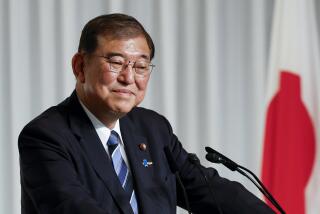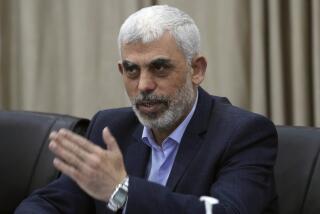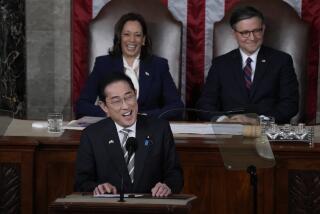A Superpower With No Helmsman : More Than a Leader, Japan Needs to Produce Leadership
The last few months have been hard ones for Japanâs prime ministers, past and present. One after another, serious ethical issues have led straight to the door of the highest official in the land.
First came the Recruit scandal, a story of pervasive bribery and illegal campaign contributions that decimated the ranks of Japanâs elected leaders like a political plague. It cost Prime Minister Noboru Takeshita his job. It reached back and latched onto former Prime Minister Yasuhiro Nakasone, who had been hoping for a chance to return as prime minister, succeeding Takeshita. Instead, Nakasone was forced to testify on Recruit before the Diet, losing his chance to be once-and-future prime minister and even his position as head of his faction in the Liberal Democratic Party. Recruit also cut across the other faction leaders, men who had once been dubbed âthe young leaders,â on the assumption that each would have his turn as prime minister in sequence. At a minimum that all-too-pat plan has been postponed--and perhaps even permanently shelved.
With an entire generation of political leaders discredited, the Liberal Democratic Party promoted the little-known but clean Sosuke Uno to the top spot, only to discover that he had his own fatal attraction for high-rent romance. Exit Mr. Uno.
The result of all this scandal is somewhat perplexing: Japan, a country that thrives on order, predictability and stability, is hard-pressed to come up with the name of an appropriate candidate for prime minister. With so many of the best-known candidates banished to the penalty box for political misconduct, the Liberal Democrats have had to dig deeper and for more obscure candidates, the latest being Toshiki Kaifu. Six months ago, who had heard of Kaifu, let alone thought he could be prime minister?
The question of who will be Japanâs next leader misses the point. The real issue is not a leader; it is leadership. Japan, in its new position as the worldâs leading lender, an economic and technological superpower, must now think carefully and freshly about its own definition of leadership. It is yet another topic where the Japanese and American views of the world seem completely at odds.
For most Japanese, the appropriate style of leadership is exemplified by the notion of the âwatoware madamâ--the hired madam who is in charge of running a house in the Ginza district of Tokyo but who is not the owner. The same view applies to the top job in the government: The prime minister should be the âhired madamâ of state.
Rather than preferring a strong, visible, articulate leader, the Japanese definition of leadership promotes the virtues of the behind-the-scenes consensus builder. That is why most Japanese considered Nakasone an aberration--practically âun-Japaneseâ--and Takeshita a return to normalcy. Nakasone was faulted for talking too much, being too articulate, making too many promises, being too much like a Western president. Takeshita, to the Japanese, was âone of us,â a poor speaker, an unassuming public figure. But what Takeshita excelled at was the inside game of consensus-building to get things done; and to the Japanese, that is the essence of leadership.
Or at least it was. The continuing crisis at the top suggests an opportunity to rethink the idea of leadership in the context of two new national conditions. Within Japan, the country is poised for a generational change in leadership. The same people have held power since the late 1940s. A new generation--affluent and arrogant--has come of age in Japan, and anxiously awaits the time when it will take over the reins of power.
Outside Japan, the rest of the world watches with new interest and concern to see what kind of leadership will emerge. Japan today is no longer a silent onlooker in global affairs. And while Japan may not yet be comfortable providing leadership, the rest of the world expects it. A willingness to speak out, the ability to communicate, to define a sense of national purpose and mission-- these skills may not appeal intuitively to the Japanese, but outside Japan, they constitute leadership.
The new reality is this: Japan in 1989 resembles the United States in 1959. Japan today has the same sense of momentum, success, unlimited capability and inevitable dominance that the United States had 30 years ago. It has a long list of issues to attack domestically--from improving the quality of life through investments in housing, transportation and recreation to providing equal opportunity for women and immigrant workers. Externally, the agenda is equally large--from playing a larger role in managing the Third Worldâs debt reduction to helping the United States regain its industrial competitiveness.
These are issues that require not just a new leader in Japan, but a whole new style of leadership. More than selecting a new prime minister, the Japanese now have the opportunity to select a new direction. The question is: âIs there a John F. Kennedy in Japanâs future?â
More to Read
Sign up for Essential California
The most important California stories and recommendations in your inbox every morning.
You may occasionally receive promotional content from the Los Angeles Times.










